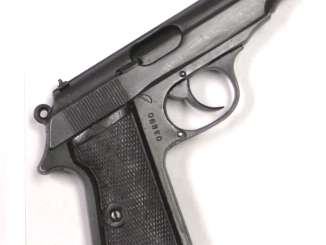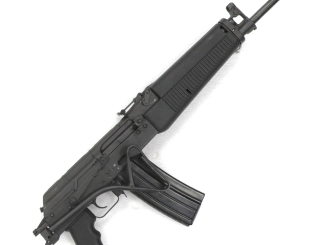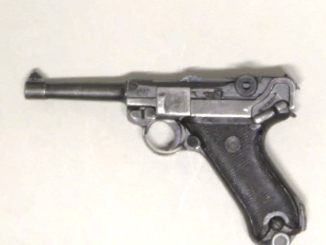One rifle that isn’t really forgotten at all but still interesting and historically significant is the Samozaryadnyj Karabin Simonova – the SKS. Predating the AK by several years, the SKS was a staple weapon in many national military forces for many years, and was one of the most affordable self-loading military surplus rifles available in the US for many more years. We have a few Russian-language manuals for the SKS, which are interesting to browse through but of rather limited utility unless you happen to read Russian.
Well, if you have an SKS and want to really learn more about maintaining and repairing it, Allegheny Arsenal has a pair of East German manuals now available translated into English. One is an Operator’s Manual covering maintenance, disassembly. and troubleshooting and the other is a very detailed Armorer’s Manual, which gets into areas as detailed as how to properly temper replacement springs, how to headspace the bolt, and with a number of dimensioned technical drawings for making replacement parts. Check ’em out!




Very nice — thanks, Ian.
That reminds me, if anyone is interested in a genuine early-model, C & R-eligible military-surplus Chinese Type 56 ( SKS ) carbine for a reasonable price, http://www.classicfirearms.com has a batch of pre-Vietnam War era guns available at $319.99 per gun. These early Type 56’s are the ones with all-milled components, including the receiver and one-piece trigger group, and are advertised as being in good to very good condition. The barrels are threaded ( not pinned ) and have the heavy-duty reinforced lugs as well.
$320 for a used Chinese Type 56 (SKS)? In Canada one of the large dealers currently has a special where if you buy a case of 1440 rounds of 7.62x39mm ammunition they will throw in a brand new Chinese Type 56 rifle for $75. Total price for both together (ammunition plus rifle) is $360. A Type 56 sold on its own is normally only $190. It’s one of the cheapest rifles of that calibre you can buy.
Is there a reason why these rifles are so expensive in the US, or is the price due to the particular model or historical association? I don’t really know a lot about the SKS in general, so I don’t know if there are big differences between the various versions.
Thanks for the input, MG.
Part of the reason for the higher prices here is demand versus supply as well as market forces in the U.S. as a whole. SKS’ used to be cheap and plentiful, until both collectors and gun enthusiasts in general started discovering them. Now we have SKS fanatics who would not trade in their carbines for a brand-new AK-47, AK-74, FN FAL, vz.58 or anything else for that matter. The social, legal and political events of the last few years have not helped any, either. The same goes for ammunition, including bulk 7.62mm x 39 purchases, which have seen a steady rise in prices, especially after the terrible Newtown massacre and the hubris that followed.
The other part of the equation in this specific case is the particular type and vintage of SKS involved. These are of the desirable early type by NORINCO, probably made either on imported Russian production machinery or on improved high-precision Chinese machinery, which are all-milled and have the original one-piece milled trigger group assembly and threaded, screw-in chrome-lined barrel with heavy lugs. The early NORINCO Type 56 ( SKS ) is generally considered to be one of the very best and most durable original-pattern SKS’ ever made, with tighter tolerances and fit-up. Later-production SKS carbines are excellent guns, but went over to more sheet-metal stampings, simplified parts configurations and assembly to cut down on costly machining and hand-fitting processes. If you really get into it, the world of SKS carbines and their history is quite fascinating, with the sort of diversity normally associated with something like the AK-47 family of weapons.
I’m assuming that the low-priced SKS you are referring to is a cheaper, later-production model. Nevertheless, I am still amazed at the pricing that you quoted for a typical SKS purchase in Canada. That is fantastic value for money under today’s circumstances, and you are fortunate to be in that situation :)!
Earl, MG and guys:
I have an early and late Chinese Type 56es, but both are Vietnam bringbacks (not mine — I postdate the war, militarily speaking). The early one has all Russian features, even to the blade bayonet. The later one was taken in the Cambodian incursion, and still had the factory cosmoline in it. It has all the late-Chinese features, but is still pretty light on stamped parts. Instead, there are clearly fewer milling setups on the receiver and bolt.
The reason SKSes went from rare to “gunshop weeds” to rare again is politics. China started shipping guns here in circa 1983 (I have an early Clayco AKMS I bought new in 1984 or 85). In 1989, import of Chinese guns was cut off after Tienanmen Square and has never been resolved. That’s why things like that AK, so-so Norinco .45s, and other Chinese imports are now collector items.
In my experience, Chinese weapons are often much better made and finished than their Russian analogues — everything from TT-33s to MiG-21s. (Russian MiGs look like the riveters got into the vodka before work). It’s easy to imagine a Chinese machinist or polisher taking pride in his craft. Of course, there could just have been a Red Guard standing behind him with one of those TTs.
I have to admit I envy you — nice collection, Kevin. Thanks for sharing your experiences with the SKS, and for the additional inputs on factors affecting SKS availability and pricing.
Kevin R. C., Be honest, are you an internet troll? This is ridiculous, how could You even compare the cheap Norinco Chineese garbage to the original, Russian or Soviet produced rifles?! MiG 21 comparison is laughable too. I guess “ignorance” and Internet “trolling” are the new “plagues” of the 21st century.
Ye You Canadians are still allowed to import Chinese weapons as well. A practice that’s been outlawed here for a couple of decades now.
This is one of importers/ retailers: https://www.canadaammo.com/product/byCategory/firearms/
You may notice that there are bunch of other, not just Chinese sourced weapons. But yes, guns of Chinese provenience were never banned here. As I do not have experience with their products, I would consider buying a pistol based on what I read. They are half to third of price of original.
What would be my center of interest as far as Chinese weapons goes, would be their current service rifle QBZ03 and possibly their new service pistol; they are not sold here yet.
Interesting, Denny. I know Canada has (by US-ian standards) rather strict laws about handguns, but the market seems healthy. I thought the Norinco CZ clone was interesting:
https://www.canadaammo.com/product/detail/norinco-nz85b-9mm/
The Nork service pistol is a much closer clone of the early CZ, but we’ll never see those in the Free World till the Kim dynasty falls. If this CZ knockoff is as well made as the Norinco .45s it’s a good buy.
SARCO in the US may still have a few of the .45s it got from Argentina. They are extremely finish worn but functional and had decent bores.
As far as the Norinco CQ M4 clone is concerned, China’s SOF are using these. And the reviewer is right, at $700 Canadian it’s a good deal. I’d be watchful for quality issues and thoroughly inspect a new one for stuff like FSB alignment and headspace. Unaware of any issues on the M4 but there are some horror stories on Norinco/Polytech M14 clones. There were some receivers that got bad heat-treating (this happened on the original M14 procurement in the USA also!)
Given the generally high quality of NORINCO products, the defective heat treating of the M-14 clones was probably an outlier that could have happened to any manufacturer per mistakes in the industrial manufacturing process. I would assume that they subsequently corrected the QA / QC issue once it was positively identified?
It looks, Kevin that there was a breakpoint in quality of Chinese production. This is probably comparable with what Japanese industrial production quality was. Novadays seldom anyone has doubt; but some inertia still persist.
My own belief is that any culture with objective is capable to achieve just as high output quality as anyone else. Its just matter of wanting and learning to get there.
As usual, you’ve stated the situation quite succinctly. Excellent observations about time and inertia in the historical/cultural/social timeline context.
Kevin’s comments and observations are also very insightful and I always learn a lot from his shared experiences.
Here in another “Chinese” classic: http://www.youtube.com/watch?v=gUMyjigEFoc
Yeah, the guy shooting it is a Cannuck (as the source where I found it claims).
USSR adopted the SKS and the AK 47 in 47, The SKS, as a rifle and the AK47 as a submashinegun, they standardlised the cartridge, for both of them. Simonov, was still chef of the development office and Federov,was stil having influence, he was in favor of a rifle as standard, and not a submashingun. When he died in 1956?, the SKS was redused to a parade weapon. The huge stores of them, was used to upgrade frindly nations armyes, among them, China.Federovhad collected systems in the old danish Madsenfactory in Kovrov, were he used to be codirektor with JTS Schouboe. Kalasnikov writes in his memoares, that it was this collection, that supleid him, with the ideas for the AK
Sorry, but the SKS was adopted in 1943, due to ww2, only special units were issued it, mainly to test its value in a war.
And here we go; it is/ was the personal influences/ connections who decided the game at least for time being. Info is appreciated, Peter.
SKS did not really do that much damage on battlefields as AK did, by far not. It is still old fashioned gun mostly by virtue of non-interchangeable magazine and absence of burst fire.